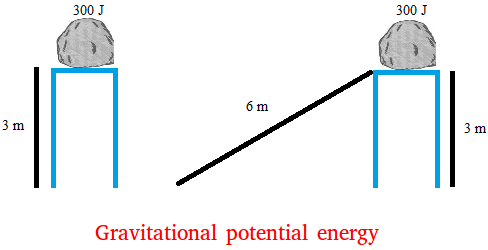Potential energy
What is potential energy? A explanation of what energy is may help us understand better.
When an object has acquired the ability to do work, we say that the object has energy.
Examples of energy
- If you compress a spring, it will acquire the ability to do work later on. We say that the spring has acquired energy.
- Other example of stored energy is the food we eat. After we eat, we are energized to do work.
- Fuel has energy since it can be used to make a car do work.
When an object stores energy as a result of its position, we say that the object has potential energy.
A trampoline is a great example of potential energy. Basically, a trampoline uses springs.
When you jump on the trampoline, the springs are stretched. You could also say that the spring experienced a change in position.
While the springs are stretched, they store potential energy. This potential energy is then released as the springs compressed sending whoever jumped on it upward.
Gravitational potential energy
A special type of potential energy is gravitational potential energy. As the word gravitational suggests, this kind of energy will happen when you elevate objects against the earth gravity.
In other words, this is energy because of gravity and this energy can do work on an object.
Example of gravitational potential energy
There is a ride at Bush Gardens in Tampa, Florida called Falcon's Fury.
The ride elevates people straight up to a certain height that is actually higher than the Statue of Liberty. Then, suddenly it drops them.
For the short period of time, may be a few seconds it keeps people in air, the ride has stored the highest gravitational potential energy for this height.
This gravitational potential energy is released when the ride drops everybody.
Gravitational potential energy formula
The amount of gravitational potential energy acquired by an object is equal to the work done against gravity in lifting the object.
Recall that W = Fd
F is the force required to move the object upward. This force is equal to the weight of the object or mg.
d is the distance the object is moved.
Suppose we move this object to a height d = h.
Then, the gravitational potential energy = mgh
Unit of potential energy
Just like work, energy is measured in Joules. This makes sense since
energy is the ability to produce work and work is measured in Joules.
Notice that the gravitational potential energy depends only on mg or the weight and the height.
It does not depends on the path you take as long as the vertical height is the same. The path could be vertical or slanted as shown below.

The only difference here is that the force required to move the rock on a slope is less than that required to move it straight up.
For the figure on the right the force is 50 N.
F = 300 J / 6 m = 50 N
However, for the figure on the left, the force is 100 N
F = 300 J / 3 m = 100 N